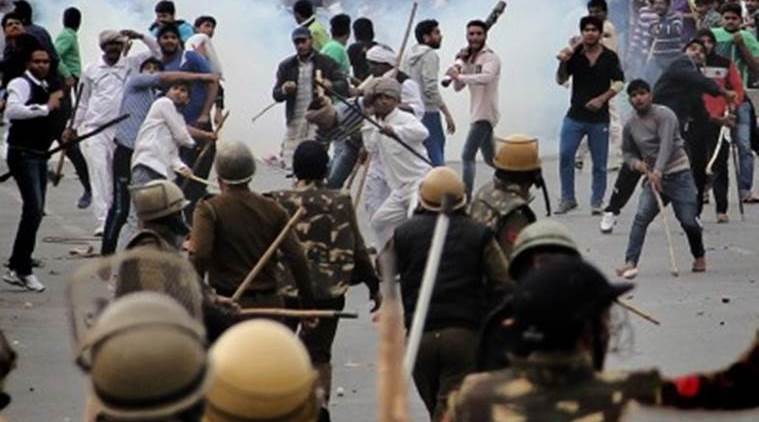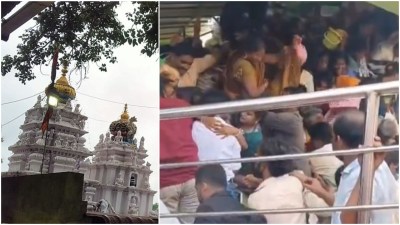Stay updated with the latest - Click here to follow us on Instagram
Jat agitation: Worst violence in Rohtak, Jhajjar took place after Army flag march
Army deployment in Haryana draws flak.
 Jat quota stir. (Source: PTI)
Jat quota stir. (Source: PTI)
Unlike in other places where the Army has been called in to aid the civilian administration in the maintenance of law and order, the presence of troops in Haryana had little effect on the violent protesters who continued with acts of arson and rioting, raising questions about why it was deployed as a force of first resort, and the erosion of authority to which it got exposed in the process.
The Army is usually summoned when a state government has exhausted all other methods, including the use of paramilitary forces, to quell dire law and order situations. Under 24 hours of violence erupting in Haryana, the government had called the Centre for the Army. Troops were sent in along with 47 companies of central paramilitary forces on the night of February 19-20.
[related-post]
The deployment was initially hampered by the roadblocks set up by the protesters. The first troops in some places had to be flown in by Indian Air Force helicopters. But even after they were in place, their presence could hardly contain the violence. In fact, the worst violence in places such as Rohtak and Jhajjar took place after army began patrolling the affected districts.
Even though the CrPC provides for the local Army commander to use force on his own in some situations without consulting the civilian administration, army sources said there were clear instructions that minimum force should be used. Officers leading the columns, the sources said, had been briefed against using any force, and not to take any step without permission from the administration.
The state government machinery, though, remained in as deep a limbo as it had been before the Army’s induction.
In a first for such situations, troops carried big placards with Army written on them in big bold red letters during flag marches. While Army officials sought to explain this as a measure to distinguish its personnel from paramilitaries wearing similar uniforms, the absence of fear among protesters even after this has called the decision into question.
The photographs of soldiers carrying the placards have been doing the rounds of the social media, and serving as well as retired Army officers have been commenting derisively on them.
“If the Army has to advertise itself, then it is a shame. They were called and not allowed to function. Once requisitioned it is Army’s job how to manage the affairs. To my mind this situation was all hotch-potch and I blame Army more than others. They get pushed when they should put their foot down. Army should be used as weapon of last resort,” said Brig Harwant Singh (retd), a military affairs commentator.
Reports from the interiors of the state where Army was deployed say protesters were hardly intimidated by the presence of the Army and were almost sure that they would not be fired upon.
Though the government has said that some of the protesters, including at Sonipat on Monday, died in firing by the security forces, the Army denies firing even a single round.
Rather, it used its network of ex-servicemen to move protesters from roadblocks. In other places where they have been deployed, soldiers have never been seen negotiating with protesters as they were doing in Haryana.
Reacting to criticism that the Army was soft on the protesters, a senior officer of Western Command said, “Aid to civil authorities is very sensitive commitment in which appropriate force has to be carefully calibrated. After all we are dealing with our own citizens”.
Haryana DGP Yash Pal Singhal told journalists that “people who are protesting are also residents of Haryana. There is no provision in law to give a free hand to the Army. Army is deployed in a state for the aid of civil administration. It is not deployed to kill people who are residents of the state”.
While the Army has been emphasising how it brought the situation in Sonipat under control without firing a single shot, questions are being asked about how this will go down in other areas where the army is deployed, such as Kashmir and the North-East, but observes few niceties.
“When the Army is called in it is meant to be requisitioned for a particular task and not with general instructions. The pussyfooting which seems to have taken place on account of dilly-dallying by the civil administration sends a wrong signal to other parts of the country where there may be similar unrest. There if the Army cracks down with more force than it did in Haryana, they can well ask why were you conciliatory in one part of the nation and harsh on another,” said Major General Krishan Khorana (retd), former Major General-in-Charge Administration, Western Command.







